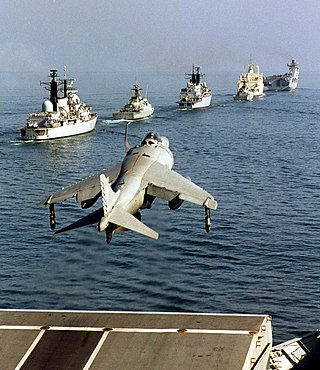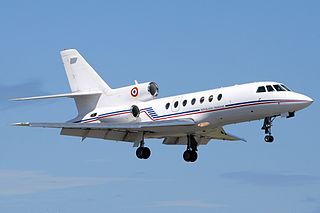
A short take-off and vertical landing aircraft is a fixed-wing aircraft that is able to take off from a short runway and land vertically. The formal NATO definition is:
A Short Take-Off and Vertical Landing aircraft is a fixed-wing aircraft capable of clearing a 15 m obstacle within 450 m of commencing take-off run, and capable of landing vertically.
A vertical take-off and landing (VTOL) aircraft is one that can take off and land vertically without relying on a runway. This classification can include a variety of types of aircraft including helicopters as well as thrust-vectoring fixed-wing aircraft and other hybrid aircraft with powered rotors such as cyclogyros/cyclocopters and gyrodynes.

The Lockheed L-1011 TriStar is an American medium-to-long-range, wide-body trijet airliner built by the Lockheed Corporation. It was the third wide-body airliner to enter commercial operations, after the Boeing 747 and the McDonnell Douglas DC-10. The airliner has a seating capacity of up to 400 passengers and a range of over 4,000 nautical miles. Its trijet configuration has three Rolls-Royce RB211 engines with one engine under each wing, along with a third engine center-mounted with an S-duct air inlet embedded in the tail and the upper fuselage. The aircraft has an autoland capability, an automated descent control system, and available lower deck galley and lounge facilities.

The Yakovlev Yak-40 is a regional jet designed by Yakovlev. The trijet's maiden flight was in 1966, and it was in production from 1967 to 1981. Introduced in September 1968, the Yak-40 has been exported since 1970.

A business jet, private jet, or bizjet is a jet aircraft designed for transporting small groups of people, typically business executives and high-ranking associates. Business jets are generally designed for faster air travel and more personal comfort than commercial aircraft, and may be adapted for other roles, such as casualty evacuation or express parcel deliveries, and some are used by public bodies, government officials, VIPs, or even the armed forces.

A jet airliner or jetliner is an airliner powered by jet engines. Airliners usually have two or four jet engines; three-engined designs were popular in the 1970s but are less common today. Airliners are commonly classified as either the large wide-body aircraft, medium narrow-body aircraft and smaller regional jet.

A vertical and/or short take-off and landing (V/STOL) aircraft is an airplane able to take-off or land vertically or on short runways. Vertical takeoff and landing (VTOL) aircraft are a subset of V/STOL craft that do not require runways at all. Generally, a V/STOL aircraft needs to be able to hover. Helicopters are not considered under the V/STOL classification as the classification is only used for aeroplanes, aircraft that achieve lift (force) in forward flight by planing the air, thereby achieving speed and fuel efficiency that is typically greater than the capability of helicopters.

The Yakovlev Yak-42 is a 100/120-seat three-engined mid-range passenger jet developed in the mid 1970s to replace the technically obsolete Tupolev Tu-134. It was the first airliner produced in the Soviet Union to be powered by modern high-bypass turbofan engines.

A tail-sitter, or tailsitter, is a type of VTOL aircraft that takes off and lands on its tail, then tilts horizontally for forward flight.

The Dassault Falcon 7X is a large-cabin, 5,950-nautical-mile [nmi] range business jet manufactured by Dassault Aviation, the second largest of its Dassault Falcon line. Unveiled at the 2001 Paris Air Show, its first flight took place on 5 May 2005 and it entered service on 15 June 2007. The Falcon 8X, first delivered on 5 October 2016, is derived from the 7X and has an extended range of 6,450 nmi made possible through engine optimization, aerodynamic refinements as well as an increase in fuel capacity. Featuring an S-duct central engine, the 7X, 8X and the Falcon 900 are the only trijets still in production, as of 2024.

A supersonic aircraft is an aircraft capable of supersonic flight, that is, flying faster than the speed of sound. Supersonic aircraft were developed in the second half of the twentieth century. Supersonic aircraft have been used for research and military purposes, but only two supersonic aircraft, the Tupolev Tu-144 and the Concorde, ever entered service for civil use as airliners. Fighter jets are the most common example of supersonic aircraft.

The Dassault Falcon 50 is a French super-midsize, long-range business jet, featuring a trijet layout with an S-duct air intake for the central engine. It has the same fuselage cross-section and similar capacity as the earlier twin-engined Falcon 20, but was a new design that is area ruled and includes a more advanced wing design.

The Yakovlev Yak-25 was a Soviet military aircraft, an early turbojet-powered fighter aircraft designed by the Yakovlev OKB. The designation was later reused for a different interceptor design. Tasked by the Council of Ministers in a directive issued on 11 March 1947, with producing a straight winged fighter similar to the earlier Yak-19, but powered by a Rolls-Royce Derwent V, OKB-115 swiftly produced the Yak-25, which blazed several trails as the first Soviet fighter with a fully pressurised cockpit, air conditioning, jettisonable canopy, and hydraulic airbrakes on the fuselage amongst other innovations.

A trijet is a jet aircraft powered by three jet engines. In general, passenger airline trijets are considered to be second-generation jet airliners, due to their innovative engine locations, in addition to the advancement of turbofan technology. Trijets are more efficient than quadjets, but not as efficient as twinjets, which replaced trijets as larger and more reliable turbofan engines became available.

The Hawker Siddeley HS-121 Trident is a British airliner produced by Hawker Siddeley. In 1957, de Havilland proposed its DH.121 trijet design to a British European Airways (BEA) request. By 1960, de Havilland had been acquired by Hawker Siddeley. The Trident's maiden flight happened on 9 January 1962, and it was introduced on 1 April 1964, two months after its main competitor, the Boeing 727. By the end of the programme in 1978, 117 Tridents had been produced. The Trident was withdrawn from service in 1995.

The Yakovlev Yak-43 was a Soviet VTOL fighter designed as the ground-based version of the ill-fated Yakovlev Yak-141, which failed to reach production. Like the Yak-141, the Yak-43 did not reach production. The Yak-43 would have been the third-generation VTOL/STOL fighter, to follow and eventually replace the Yak-141.

The China Aviation Museum is an aviation museum located in Beijing, China. It is affiliated with the People's Liberation Army Air Force and co-sponsored by the Aviation Industry Corporation of China. The museum is a national first-class museum accredited by the National Cultural Heritage Administration.
























